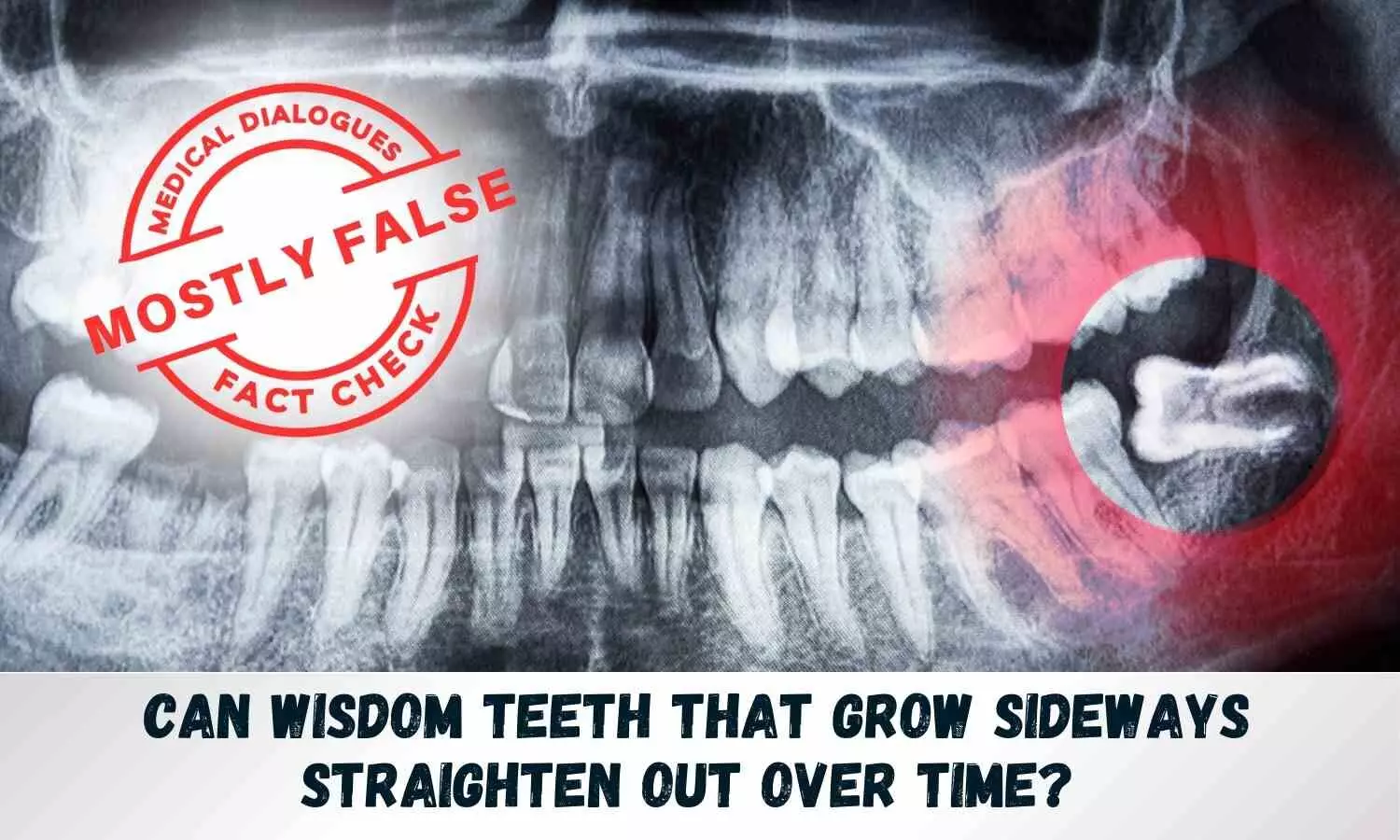Fact Check: Can wisdom teeth that grow sideways straighten out over time?

A post on Instagram claims that wisdom teeth(third molars) grown sideways can straightened out over time. The claim is Mostly False.
Claim
An Instagram post claims that "wisdom teeth(third molars) grown sideways will straighten out overtime and it should not be removed".
In the post, the user thewarriorcenter further explains that pain from erupting wisdom teeth is intentional and serves a purpose by helping to rewire the brain and create new pathways." The adrenaline released during the pain is described as a hidden gift from God, contributing to this process. The claim also connects wisdom teeth to important parts of the body, such as the pineal gland, central nervous system, heart, and intestines, suggesting that they play a significant role in overall health. It argues that wisdom teeth are called "wisdom teeth" for a reason, implying they are tied to a person's potential, and that removing them disrupts an important nerve pathway from the brain, thereby diminishing this potential.
Amongst other claims, the post makes a claim that wisdom teeth grown sideways will straighten out overtime and should not be removed.
The post has 71,861 likes and can be accessed here.
Fact Check
The claim is Mostly false. While many studies have observed changes in the angulation of impacted wisdom teeth (also known as third molars) over time, none have supported the claim that wisdom teeth growing sideways can straighten out naturally over time.
What are Wisdom Teeth AKA Third Molars?
Third molars, commonly referred to as "wisdom teeth," are the last set of molars to develop. Third molars are considered permanent teeth like the rest of the molars with no predecessors. The first evidence of calcification for third molars is estimated to be as early as 7 and 8 years of age for the maxillary and mandibular variants. Complete radicular(root) development of the third molars may be at 25 years of age. The estimated age at which third molars erupt is between 17 and 21 years.
Understanding The Tooth Impaction
The impacted tooth is a tooth that is completely or partially unerupted and is positioned against another tooth, bone or soft tissue so that its further eruption is unlikely, described according to its anatomic position.
Impacted teeth may remain asymptomatic or may be associated with various pathologies such as caries, pericoronitis, cysts, tumours, and also root resorption of the adjacent tooth.
Impacted third molars are commonly encountered in routine dental practice. The impaction rate is higher for third molars when compared with other teeth. The highest prevalence of impacted teeth in the permanent dentition is the mandibular(lower) third molars followed by maxillary(upper) third molars. The mandibular third molar impaction is said to be due to the inadequate space between the distal of the second mandibular molar and the anterior border of the ascending ramus of the mandible.
Classification For the Impacted Wisdom Teeth (Third Molars)
Based on the angulation of the tooth (Winter’s classification) lower wisdom teeth's impaction can be classified as Vertical (38%), Mesioangular (43%), Horizontal (3%), Distoangular (6%), Buccoangular, Linguoangular, Inverted, Unusual.
Figure: Classification of impacted Mandibular 3rd Molar According to Angulation of the Tooth (Winter’s classification)
Reference: Varghese, G. (2021). Management of Impacted Third Molars. In: Bonanthaya, K., Panneerselvam, E., Manuel, S., Kumar, V.V., Rai, A. (eds) Oral and Maxillofacial Surgery for the Clinician. Springer, Singapore. https://doi.org/10.1007/978-981-15-1346-6_14
Causes of Impacted Wisdom Teeth (Third Molars)
The gradual evolutionary reduction in the size of the human mandible(lower jaw) and maxilla(upper jaw) has led to jaws that are too small to accommodate the corresponding molars. Additionally, it has been observed that the modern diet requires less chewing effort, which reduces the growth stimulation of the jaws, contributing to the occurrence of impacted and unerupted teeth in modern humans.
Why do we need to remove impacted Wisdom Teeth (Third Molars)?
Third molars are the last teeth to erupt and have a relatively high likelihood of becoming impacted. As a result, their surgical extraction has become the most frequent type of dentoalveolar surgery. In 1979, the National Institutes of Health Consensus Development Conference outlined several indications for removing impacted wisdom teeth(third molars), including infection, nonrestorable cavities, cysts, tumours, and destruction of adjacent teeth and bone.
Can wisdom teeth (Third Molars) that grow sideways straighten out over time?
Although numerous studies have identified changes in the angulation (that is change in angle) of impacted third molars, there is no scientific evidence or medical consensus to support the claim that wisdom teeth growing sideways will straighten out on their own over time.
A study published in the Journal of Research in Dental and Maxillofacial Sciences presented a case report of a 22-year-old female with an asymptomatic mesioangular impacted lower right third molar ( that is wisdom tooth). Eight years later, at her next visit, a new panoramic radiograph revealed that the crown of the tooth had shifted toward the roots of the adjacent tooth, changing the impaction from mesioangular to horizontal. The study also concluded that if obstacles in the eruption path can be eliminated for a tooth with an intact PDL(periodontal ligament) and root system, the eruption may proceed as expected.
The study by Nance et. al. showed that 44% of impacted maxillary third and 26% of impacted mandibular third molars changed angulation or position. Additionally, in their study on 237 patients, one out of three vertical/distal maxillary and mandibular impacted third molars and 11% of mesial/horizontal lower third molars erupted to the occlusal plane during follow-up from the baseline.
Yet another study by Hattab et. al. found that the impacted mandibular third molars, originally presented at 35 degrees or more had an average decrease of 12 degrees in angulation, meaning that teeth moved closer to an upright position.
Some studies have demonstrated changes in the angulation of mandibular third molars in orthodontic cases. Notably, a study published in the Journal of Contemporary Dental Practice reported the worsening of mandibular third molar angulation after the extraction of the first premolar in high anchorage cases.
Dr. Alpha Mary Mathew, Assistant Professor, Dept. of Oral & Maxillofacial Surgery, Rungta College of Dental Sciences & Research, Bhilai, C.G told Medical Dialogues that, "As a dentist, it's important to clarify that while some changes in the positioning of impacted wisdom teeth can occur over time, there is no reliable scientific evidence to support the idea that wisdom teeth growing sideways will straighten out on their own. Wisdom teeth often become impacted because there's not enough space in the jaw for them to emerge properly, and when they grow at an angle, this can lead to a variety of problems, including infection with pain and swelling, dental caries, root resorption and deterioration of adjacent teeth. It’s crucial to visit a dentist and get that diagnosed."
Dr. Ritu Thawait, Dental Surgeon, Medical Officer, CHC, Risali, Durg, C.G also added "We often get questions about whether sideways-growing wisdom teeth can straighten out by themselves. The truth is, there’s no scientific proof that this happens naturally. Impacted wisdom teeth usually stay in the same position or can even shift further, potentially causing pain, swelling, infections, or damage to nearby teeth. Waiting to see if they will correct on their own, will be wasting time."
Medical Dialogues Final Take
Although wisdom teeth can experience changes in position over time, these shifts are unpredictable and differ from case to case. One cannot depend on the natural repositioning of impacted wisdom teeth, as they are unlikely to straighten on their own. Based on their position and the appearance of any symptoms, such as pain or infection, it may be necessary to intervene with extraction to prevent further issues like infections or harm to surrounding teeth. Hence, the claim that wisdom teeth that grow sideways straighten out over time is mostly false.



